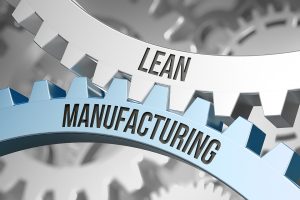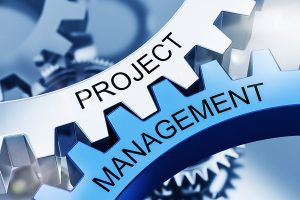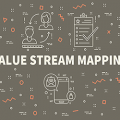
Lean Project Management is the application of lean concepts to project management methodologies.
Lean is a method used in the manufacturing industry which results in significant increases in product quality and production efficiency. Project management, on the other hand, seeks to produce one single product or service (or just a few) while satisfying stakeholders and project requirements.
Since projects use a defined process to create a product for a customer, much like a manufacturing plant does, lean project management’s ruthless efficiency results in higher project quality, more met deadlines, and lower project costs.
Welcome to Lean Project Management!
First, some background.
What is Lean Manufacturing?
Lean manufacturing emerged from the success of the Toyota Production System after Toyota arose from near ruin out of the ashes of WWII to become the world’s largest automaker in the 1990’s.
 Lean manufacturing has 5 core principles:
Lean manufacturing has 5 core principles:
- Define Value
The initial step is to define value. Value is something that someone is willing to pay for, and the value in lean manufacturing is the product itself – That is, the raw materials, intermediate and finished products, because this is what the customer pays for. It may sound simple, but many businesses lose sight of where the value is, focusing more on maximizing uptime and minimizing labor costs. Not that those aren’t important, but products that sit idle as inventory between production stations are not generating revenue even though they had to be purchased. You will find this central theme throughout lean thinking, that it is more important to keep the value (product) flowing than to maximize the uptime of people and machinery. - Identify the Value Stream
The value stream is the steps which create the item of value. For example, cutting, stamping, and painting. These represent the process of creating the value for which the customer is willing to pay. - Create Flow
This is where lean differs drastically from traditional manufacturing. The goal is to move the product from raw material to finished good as rapidly as possible, with little or no wait time between processing stations. This requires each station to use the same processing time, called the takt time, and some stations may need 2, 3, or more sub-processing stations to realize this. If additional manufacturing capacity is needed, multiple parallel assembly lines are created. The result is many, small machines instead of one big one, which reduces catastrophic failures and allows rapid changeovers for product variants. - Pull
When good flow exists, the assembly line can begin moving in response to customer demand (pull) instead of the plant’s desire to sell a certain good (push), which is the norm in non-lean plants. Lean assembly lines have a small footprint and are easily changed over from one product to the next (or adjusted to product variations), hence the plant adjusts rapidly to market and individual customer demands. Specifically, when an order is received, the kanban system produces a “card” (tracking mechanism) which contains all of the production steps necessary to produce that variation of product, and moves with the product from start to finish. No kanban card, no production. - Continuous Improvement
In a lean assembly line, the product is always moving. This gives the operators the opportunity to inspect the line and make continual process improvements (called kaizen) to reduce the takt time or introduce any efficiencies.
Lean Project Management
In a sense, project management is the exact opposite to manufacturing, because:
- Projects are temporary, whereas manufacturing is ongoing (or many production units)
- Projects are unique, whereas manufacturing is repetitious
In spite of this, projects and manufacturing operations have something fundamental in common, which is that they use machines and people to produce a final product. Although it could be a service, an information product, or one large item, the products are produced and delivered to a customer. And it is this similarity that allows lean manufacturing concepts to improve project management.
How to Implement Lean Project Management
Lean project management is implemented throughout each project phase:
- Initiation
- Planning
- Execution
- Monitoring and Control
- Closing
Initiation
During project initiation, the value is defined (lean principle #1). The project charter specifies the item of value which the project is to produce. It defines the project requirements, that is, the quality standards, maintenance and support requirements, interim deliverables, or any other item necessary for project success.
Planning
During the planning phase, the value stream is identified and mapped (lean principle #2). In project management, the work breakdown structure (WBS) is already a good value stream map, as it identifies the steps the product will take in its journey to becoming a finished good.
Lean project management develops a project schedule which specifies the time that each task will require to complete.
Execution
Execution is where lean project management excels. Lean concepts are implemented in the following ways throughout the project execution phase:
- Flow
The products being produced, whether tangible goods, information products, or services, do not stop moving once they have entered the production process (lean principle #3). For projects where full time work is not required at certain stages, a set of deliverables, or partial deliverables, must be documented at regular intervals. For example,- In construction, the tradespeople are lined up as tight as possible without any gaps
- In engineering, plans and specifications must be produced in a continuous takt time
- In software development, functionality must be demonstrable on a continuous cycle, daily, weekly, or whatever best suits the project.
- In a training course project, the training materials must be produced at a rate of a certain number of powerpoint slides per week (or whatever measurement works best)
- Inventory
Inventory is minimized. This takes the form of maximizing the work delivered to the customer. Anytime something can be completed without any additional inputs, the work is finished and delivered to the customer.- In construction, where any component of the project can be completed and accepted by the owner at some mid-point, this is done.
- In engineering, the drawings and specifications are certified complete (stamped) one at a time instead of waiting until they are all complete.
- In software development, product functionality is delivered to the owner for acceptance in stages rather than the full product.
- In a training course project, the training materials cannot be delivered until the training course takes place, but they can be fully completed in stages (chapter 1 complete as soon as possible instead of working on all chapters at once).
- Kaizen (continuous improvement)
The process is continually monitored for waste, or anything that is not absolutely necessary to produce the value (product). Lean principle #5 takes the form of highly active project scope management, whereby the work breakdown structure is relentlessly monitored for scope creep, and each task is scrutinized daily to ensure there is no gold plating. Lean project management is highly efficient.
Monitoring & Control
In lean project management, each project team member is empowered to “push the big, red button” anytime they notice a quality problem. The task immediately stops until the issue can be rectified or dealt with. Each individual product is given this treatment – it does not proceed to the next project task until its quality level meets the specified standard.
Lean project management utilizes the lean concept of jidoka, whereby product quality is measured at each production station and any quality issues are immediately corrected, even via shutting down the assembly line if necessary. Hence, each project task is measured, either quantitatively by measurement, or qualitatively by human judges prior to the task being certified as complete.
At Toyota, the big red button was placed at each station and line workers were not only allowed to use it, it was considered their responsibility when the production station did not meet its quality standards.
Closing
Lean project management seeks to hand over deliverables to the customer at the earliest possible time. Even partial deliverables are produced and delivered at the earliest possible interim points so that project acceptance is quick and painless for all stakeholders.
Remove Muda (Waste)
 Once lean manufacturing is implemented at a facility, the focus becomes a relentless pursuit of waste (or non-peak efficiency) within the production process. Anything that is not absolutely necessary to produce the value (product) is considered muda, or waste, and must be eliminated.
Once lean manufacturing is implemented at a facility, the focus becomes a relentless pursuit of waste (or non-peak efficiency) within the production process. Anything that is not absolutely necessary to produce the value (product) is considered muda, or waste, and must be eliminated.
There are seven kinds of waste, and the project management process must continually seek to identify and rapidly eliminate it:
- Overproduction
This refers to producing too much product which is then scrapped. In most projects this takes the form of gold-plating, or producing a higher quality than the customer is willing to pay for. Gold plating results in scope creep and budget overruns. - Waiting
The product must not be left waiting at any location in the production line. In a project based environment, the product has a deadline which results in negative consequences if not met, but no corresponding positive benefits if achieved. If the product is continuously advanced, expectations will be exceeded which may result in additional business. - Transporting
If the project transports materials or equipment from place to place, this must be minimized. The unnecessary transportation of raw materials, finished goods, or any other intermediate item is muda. - Overprocessing
Making poor equipment or manpower choices or engineers making specifications that are beyond the needs of the customer constitute overprocessing waste. - Inventory
All inventory is waste unless it translates directly into sales. Most projects determine their raw material needs prior to project execution, but if the raw materials are ordered too early and require excessive storage, this is waste. - Motion
The unnecessary movement of people, such as workers searching for tools and equipment. In a project context, the overall effort is usually considered, and whether the people and goods are translating into a finished product on time. However, lean project management eliminates the waste of unnecessary people movement. - Defects
The PMBOK Guide already contains a process for scope validation, which refers to the review of the finished product with the customer to ensure it is satisfactory and meets project requirements. Hence, this type of waste is already covered in traditional project management.
An eighth type of waste is generally accepted as part of the lean manufacturing methodology, and its applicability to project management is particularly striking:
- Unused knowledge
Because projects produce only one (or just a few) products, it is particularly necessary to actively manage project knowledge, ensuring that the required knowledge is either present or reasonably obtainable.
Conclusion
Good luck with your implementation of lean project management, and most definitely leave a comment to let us all know what you did and how it turned out!







